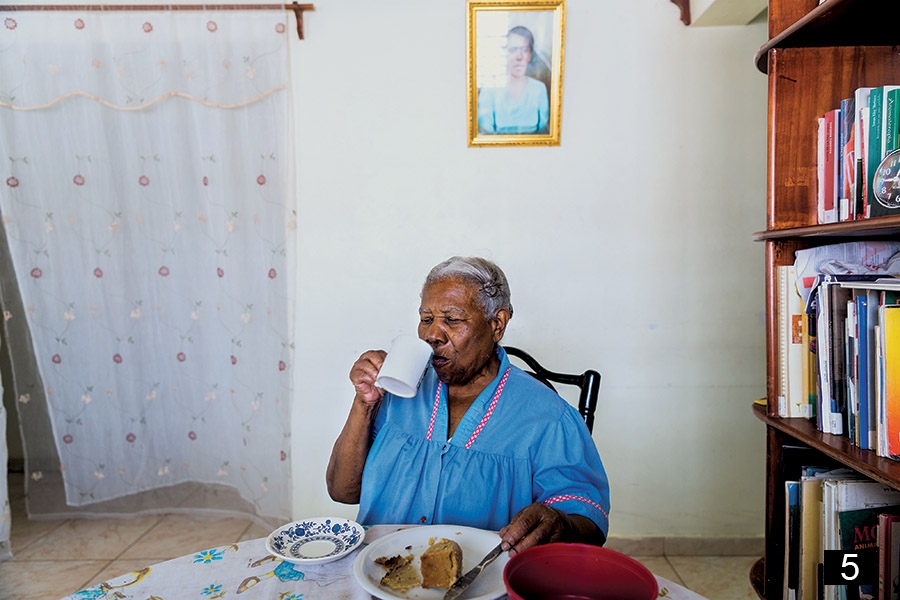
Portland Magazine
January 31, 2019
 How one writer aims to complicate the narratives we think we know—and shine a warm light on those we don’t.
How one writer aims to complicate the narratives we think we know—and shine a warm light on those we don’t.
Story and Photos by Walter Thompson-Hernández '09
When I was a child, I used to spend countless hours in my family’s backyard staring at the airplanes that flew miles above our home in Southeast Los Angeles. I would lie on my back on the grass, close my eyes, and imagine where the planes were flying from.
As they approached nearby Los Angeles International Airport, I could sometimes distinguish the airline according to the logo or color scheme. International flights usually had more colorful designs than domestic flights, and they usually spent less time taxiing around the airport.
Back in those days, it was economically unfathomable for my family to travel outside of Los Angeles, so those fleeting moments allowed me to imagine a world that was larger than my neighborhood. As I stared at each plane, I wondered how many countries the passengers had traversed on their way to Los Angeles. I was drawn to details, and since I did not have them, I would fill in the blanks with vivid descriptions. Each passenger, I imagined, had an intriguing story to share. And I had a burning desire to know it.
Years later, as a New York Times reporter, it dawned on me that my passion for storytelling emerged from those countless hours I’d spent looking at the planes that flew above our home. They were my introduction to the vastness of the human experience, that people had to make sense of the worlds they entered and the ones they left behind. Which one did they call home? Where did they feel they belonged?
As the child of an African-American father and a Mexican mother, I often struggled with these questions. I never truly felt like I belonged: I was never black enough for my African-American friends, and I was never quite “Mexican” enough for my Latino friends. I grew up in a part of Los Angeles where economic and social conditions often caused racial tensions between both groups. This reality was impossible to avoid. Race riots were frequent, and I was often forced to pick sides. Thus, I eventually arrived at one salient point: my life would be largely defined by the ways that I belong and do not belong to an identity, a group, or in this case, a race. It would be my mission to understand how people around the world also processed their identities.

One of my first stories as a New York Times reporter took me only minutes away from the neighborhood that I grew up in. My assignment was to profile a thriving horse ranch in the heart of Compton, California. While the words “horse ranch in Compton” might sound paradoxical given the history of the neighborhood and its representation in popular media, a sizeable, yet secluded horse ranch exists in the middle of one of the most stigmatized communities in the United States. It’s led by a group of 10 African-American childhood friends called the “Compton Cowboys,” who at an early age chose to ride horses to avoid the temptation of gangs and violence in their community. When I was asked to write about them, this group of friends was relatively unknown to people in the United States and throughout the world. But their mission to transform stereotypes about black cowboys and re-insert the black cowboy into the history books began long before I came knocking on their front door to interview them.
 Before meeting with them, I thought about the ways that the city of Compton was typically covered by reporters. Most stories revolved around crime, violence, and chaos. Films like the 2015 blockbuster Straight Outta Compton only confirmed many of its preexisting stereotypes. But because I grew up minutes away from Compton, I knew that the Compton Cowboys’ story presented me with an opportunity to cover that community and their stories in a much more nuanced way. I knew I could complicate the typical inner-city survival narrative.
Before meeting with them, I thought about the ways that the city of Compton was typically covered by reporters. Most stories revolved around crime, violence, and chaos. Films like the 2015 blockbuster Straight Outta Compton only confirmed many of its preexisting stereotypes. But because I grew up minutes away from Compton, I knew that the Compton Cowboys’ story presented me with an opportunity to cover that community and their stories in a much more nuanced way. I knew I could complicate the typical inner-city survival narrative.
My background in academia also prepared me to tell this story. Prior to working for the Times, I had earned a master’s degree from Stanford University and was enrolled in a doctoral program in Chicano Studies at the University of California, Los Angeles (UCLA) for one year. I was trained as an ethnographer—essentially an anthropologist who uses a research method designed to help academics understand individuals and communities (and their belief systems). Using an extensive hands-on, on-the-scenes approach, guided by lengthy field notes, observations, and in-depth interviews, this research method often takes copious amounts of time.
I learned that ethnography also had a dark past. During the nineteenth and twentieth centuries, colonial powers used this method—often sending anthropologists on fully funded expeditions—to learn about the environment and people of these places. In essence, these research missions were a way for those in power to learn about the colony and establish a trade economy guided by the extraction of raw materials, minerals, and other valuable resources.
As technology developed in the late nineteenth century, scientists and explorers began using photography to help document their experiences. These researchers were no longer solely relegated to detailed notes and written accounts. Cameras created visual worlds for both the explorers and their audiences. But scientists often produced images for people back in Europe that only confirmed pre-existing stereotypes about these often vulnerable communities. In countries like Brazil and Guyana, photographic subjects were often asked to take off their clothing to pose for photographs regardless of their occupation. Sometimes subjects were asked to perform lewd sexual acts in front of the camera. These contrived images served a larger purpose: they helped validate the notion that people of African descent and indigenous descent in the new world were savages in desperate need of religious and colonial order.
Learning about ethnography’s controversial past inspired me to rethink my approach to the communities that I would be spending time with through my reporting. One of the key differences between an ethnographer and a journalist was the amount of time that I could spend covering a story. I would not have the luxury of spending months with a community, but I was determined not to sacrifice depth of understanding or the integrity of the story. I wanted to challenge a relatively common tradition in both the academic and journalistic worlds: the act of “parachuting” into a community, extracting information, and leaving without forming a genuine connection with that community.
We’ve all watched those television clips. A reporter is standing in the middle of what seems like a relatively hostile environment in a developing nation. They are surrounded by a community of darker skinned people who do not look like the reporter. Sometimes the interviewees are dressed in traditional ethnic garb or wearing camouflaged clothing and brandishing high-powered firearms. The reporter is usually white and makes repeated attempts at “connecting” with the people he is interviewing as he asks about the current political climate.
But something about this entire situation also seems off. It seems transactional and contrived. Or, worse, exploitative. The questions seem aimed at the sensational sound bite. Neither the reporter nor the interviewee appears entirely comfortable being there. After the cameras are turned off, the production team typically packs up their things and heads back to their hotel and never communicates with that community again.
This is what “parachuting” into a community often looks like. It happens both in academic contexts and in the media world. While shrinking budgets and resources have drastically limited the amount of time one can spend in the field, I would argue that reporters can still engage with communities in respectful ways. We must always remember that the people we are interviewing are, in fact, the experts of their own story.
My approach to storytelling strongly reflects this last point. I aim to form lasting connections with the communities that I spend time with. I am deeply concerned with preserving integrity and authenticity while maintaining the utmost respect for human connection. I do not think about the people I interview as subjects, and I do not approach communities as an expert. I am a listener first and a reporter second. They are the only experts. I am just a medium between them and the world.
As I continue to work on stories throughout the world, I find that I almost always identify with the communities that I cover. We often experience the world with the same racial and ethnic lens, and a familial relationship almost always carries on long after the story is finished.
Storytelling has allowed me to preserve the stories of communities around the world who have never had the ability to share their stories. Many have been historically disenfranchised and voiceless because of forces outside of their control. Some of the communities that I have covered have intentionally wanted to live isolated lives. They have endured through years of discrimination and have formed a formidable distrust for the western world. Others have been waiting for the opportunity to share their story as a way to preserve their legacy.
Early in 2018, for example, I spent time with a community of people from Samana, Dominican Republic, a port town with a population of roughly 100,000 residents. I was there to interview the descendants of a group of more than 300 free African-Americans who chartered a ship and migrated to the Dominican Republic in 1824.

At the time, the Dominican Republic was the Haitian-controlled island of Hispaniola. The then president of Haiti, Jean-Pierre Boyer, enlisted the support of mediators in the United States and around the world to help populate Haiti with more people of African descent. He promised property and employment. A sizeable yet shrinking group of these initial descendants continue to live in Samana. They preserve the memory of their ancestors by attending weekly church services that have been around since their relatives first arrived almost 200 years ago.
Spending time with them helped me understand the complex nature of storytelling. While many were reluctant to share their story, some wanted it to be known. Some feared that I would get their story wrong. Others believed that I worked for the government and was interested in stealing their information and home titles. Still, each one of them knew that speaking with me would change the course of their lives forever. They trusted me with their story, and I had to make sure the legacy of their relatives would be put out into the world in the same way that it was shared with me.

As the world becomes increasingly connected through social media, I continue to think about the meaning of belonging as it relates to communities like the Compton Cowboys and the descendants of African-American settlers in Samana, Dominican Republic. What does a community gain or lose when their story gets out into the world? Does exposure always mean that their struggle to belong will cease? The answer will vary, but one thing is certain: the need to belong will continue to exist for generations to come. And it will be increasingly important for storytellers to portray these communities and their changing worlds with integrity.
WALTER THOMPSON-HERNÁNDEZ ’09 is a member of the “Surfacing” team at The New York Times. He is working on two books—one for adults and one for children—about the Compton Cowboys. Read more about the Compton Cowboys.
PHOTOS: 1) Taylor Wade (left) and Keiara Wade (right), Compton, CA; 2) Tre Hosley, Compton, CA; 3) Tre Hosley, Compton, CA; 4) Victoria Copeland Sheppard, Samana, Dominican Republic; 5) Martha Wilmore, Samana, Dominican Republic.
University of Portland
5000 N. Willamette Blvd.,
Portland, Oregon 97203-5798
503.943.8000
This website uses cookies to track information for analytics purposes. You can view the full University of Portland privacy policy for more information.
